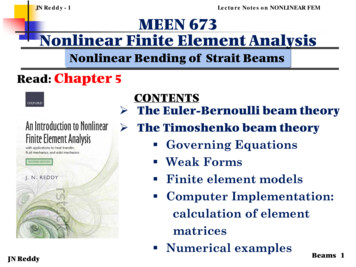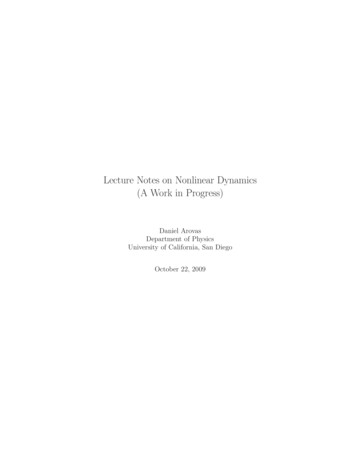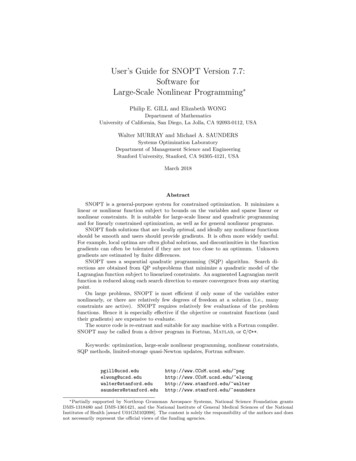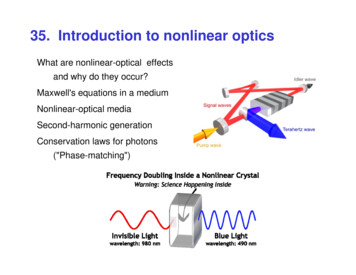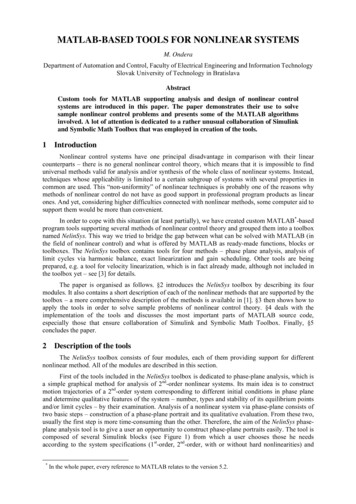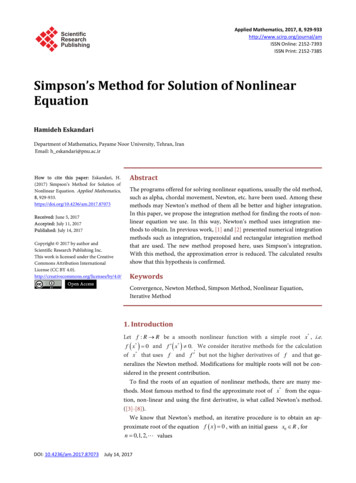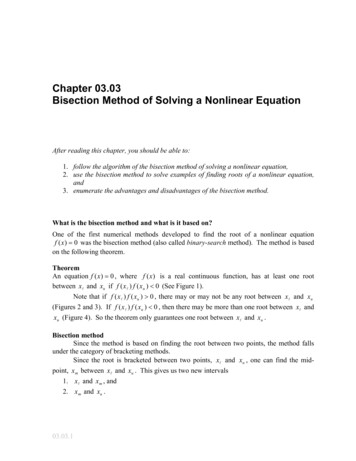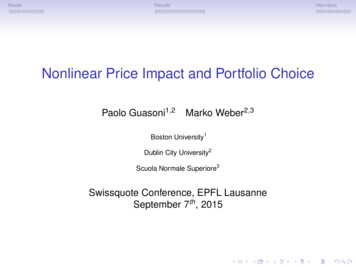
Transcription
ModelResultsHeuristicsNonlinear Price Impact and Portfolio ChoicePaolo Guasoni1,2Marko Weber2,3Boston University1Dublin City University2Scuola Normale Superiore3Swissquote Conference, EPFL LausanneSeptember 7th , 2015
ModelResultsOutline Motivation:Optimal Rebalancing and Execution. Model:Nonlinear Price Impact.Constant investment opportunities and risk aversion. Results:Optimal policy and welfare. Implications.Heuristics
ModelResultsOutline Motivation:Optimal Rebalancing and Execution. Model:Nonlinear Price Impact.Constant investment opportunities and risk aversion. Results:Optimal policy and welfare. Implications.Heuristics
ModelResultsOutline Motivation:Optimal Rebalancing and Execution. Model:Nonlinear Price Impact.Constant investment opportunities and risk aversion. Results:Optimal policy and welfare. Implications.Heuristics
ModelResultsHeuristicsPrice Impact and Market Frictions Classical theory: no price impact.Same price for any quantity bought or sold.Merton (1969) and many others. Bid-ask spread: constant (proportional) “impact”.Price depends only on sign of trade.Constantinides (1985), Davis and Norman (1990), and extensions. Price linear in trading rate.Asymmetric information equilibria (Kyle, 1985), (Back, 1992).Quadratic transaction costs (Garleanu and Pedersen, 2013) Price nonlinear in trading rate.Square-root rule: Loeb (1983), BARRA (1997), Grinold and Kahn (2000).Empirical evidence: Hasbrouck and Seppi (2001), Plerou et al. (2002),Lillo et al. (2003), Almgren et al. (2005). Literature on nonlinear impact focuses on optimal execution.Portfolio choice?
ModelResultsHeuristicsPrice Impact and Market Frictions Classical theory: no price impact.Same price for any quantity bought or sold.Merton (1969) and many others. Bid-ask spread: constant (proportional) “impact”.Price depends only on sign of trade.Constantinides (1985), Davis and Norman (1990), and extensions. Price linear in trading rate.Asymmetric information equilibria (Kyle, 1985), (Back, 1992).Quadratic transaction costs (Garleanu and Pedersen, 2013) Price nonlinear in trading rate.Square-root rule: Loeb (1983), BARRA (1997), Grinold and Kahn (2000).Empirical evidence: Hasbrouck and Seppi (2001), Plerou et al. (2002),Lillo et al. (2003), Almgren et al. (2005). Literature on nonlinear impact focuses on optimal execution.Portfolio choice?
ModelResultsHeuristicsPrice Impact and Market Frictions Classical theory: no price impact.Same price for any quantity bought or sold.Merton (1969) and many others. Bid-ask spread: constant (proportional) “impact”.Price depends only on sign of trade.Constantinides (1985), Davis and Norman (1990), and extensions. Price linear in trading rate.Asymmetric information equilibria (Kyle, 1985), (Back, 1992).Quadratic transaction costs (Garleanu and Pedersen, 2013) Price nonlinear in trading rate.Square-root rule: Loeb (1983), BARRA (1997), Grinold and Kahn (2000).Empirical evidence: Hasbrouck and Seppi (2001), Plerou et al. (2002),Lillo et al. (2003), Almgren et al. (2005). Literature on nonlinear impact focuses on optimal execution.Portfolio choice?
ModelResultsHeuristicsPrice Impact and Market Frictions Classical theory: no price impact.Same price for any quantity bought or sold.Merton (1969) and many others. Bid-ask spread: constant (proportional) “impact”.Price depends only on sign of trade.Constantinides (1985), Davis and Norman (1990), and extensions. Price linear in trading rate.Asymmetric information equilibria (Kyle, 1985), (Back, 1992).Quadratic transaction costs (Garleanu and Pedersen, 2013) Price nonlinear in trading rate.Square-root rule: Loeb (1983), BARRA (1997), Grinold and Kahn (2000).Empirical evidence: Hasbrouck and Seppi (2001), Plerou et al. (2002),Lillo et al. (2003), Almgren et al. (2005). Literature on nonlinear impact focuses on optimal execution.Portfolio choice?
ModelResultsHeuristicsPrice Impact and Market Frictions Classical theory: no price impact.Same price for any quantity bought or sold.Merton (1969) and many others. Bid-ask spread: constant (proportional) “impact”.Price depends only on sign of trade.Constantinides (1985), Davis and Norman (1990), and extensions. Price linear in trading rate.Asymmetric information equilibria (Kyle, 1985), (Back, 1992).Quadratic transaction costs (Garleanu and Pedersen, 2013) Price nonlinear in trading rate.Square-root rule: Loeb (1983), BARRA (1997), Grinold and Kahn (2000).Empirical evidence: Hasbrouck and Seppi (2001), Plerou et al. (2002),Lillo et al. (2003), Almgren et al. (2005). Literature on nonlinear impact focuses on optimal execution.Portfolio choice?
ModelResultsHeuristicsPortfolio Choice with Frictions With constant investment opportunities and constant relative risk aversion: Classical theory: hold portfolio weights constant at Merton target. Proportional bid-ask spreads:hold portfolio weight within buy and sell boundaries (no-trade region). Linear impact:trading rate proportional to distance from target. Rebalancing rule for nonlinear impact?
ModelResultsHeuristicsPortfolio Choice with Frictions With constant investment opportunities and constant relative risk aversion: Classical theory: hold portfolio weights constant at Merton target. Proportional bid-ask spreads:hold portfolio weight within buy and sell boundaries (no-trade region). Linear impact:trading rate proportional to distance from target. Rebalancing rule for nonlinear impact?
ModelResultsHeuristicsPortfolio Choice with Frictions With constant investment opportunities and constant relative risk aversion: Classical theory: hold portfolio weights constant at Merton target. Proportional bid-ask spreads:hold portfolio weight within buy and sell boundaries (no-trade region). Linear impact:trading rate proportional to distance from target. Rebalancing rule for nonlinear impact?
ModelResultsHeuristicsPortfolio Choice with Frictions With constant investment opportunities and constant relative risk aversion: Classical theory: hold portfolio weights constant at Merton target. Proportional bid-ask spreads:hold portfolio weight within buy and sell boundaries (no-trade region). Linear impact:trading rate proportional to distance from target. Rebalancing rule for nonlinear impact?
ModelResultsHeuristicsPortfolio Choice with Frictions With constant investment opportunities and constant relative risk aversion: Classical theory: hold portfolio weights constant at Merton target. Proportional bid-ask spreads:hold portfolio weight within buy and sell boundaries (no-trade region). Linear impact:trading rate proportional to distance from target. Rebalancing rule for nonlinear impact?
ModelResultsHeuristicsThis Talk Inputs Price exogenous. Geometric Brownian Motion. Constant relative risk aversion and long horizon. Nonlinear price impact:trading rate one-percent higher means impact α-percent higher. Outputs Optimal trading policy and welfare. High liquidity asymptotics. Linear impact and bid-ask spreads as extreme cases. Focus is on temporary price impact: No permanent impact as in Huberman and Stanzl (2004) No transient impact as in Obizhaeva and Wang (2006) or Gatheral (2010).
ModelResultsHeuristicsThis Talk Inputs Price exogenous. Geometric Brownian Motion. Constant relative risk aversion and long horizon. Nonlinear price impact:trading rate one-percent higher means impact α-percent higher. Outputs Optimal trading policy and welfare. High liquidity asymptotics. Linear impact and bid-ask spreads as extreme cases. Focus is on temporary price impact: No permanent impact as in Huberman and Stanzl (2004) No transient impact as in Obizhaeva and Wang (2006) or Gatheral (2010).
ModelResultsHeuristicsThis Talk Inputs Price exogenous. Geometric Brownian Motion. Constant relative risk aversion and long horizon. Nonlinear price impact:trading rate one-percent higher means impact α-percent higher. Outputs Optimal trading policy and welfare. High liquidity asymptotics. Linear impact and bid-ask spreads as extreme cases. Focus is on temporary price impact: No permanent impact as in Huberman and Stanzl (2004) No transient impact as in Obizhaeva and Wang (2006) or Gatheral (2010).
ModelResultsHeuristicsThis Talk Inputs Price exogenous. Geometric Brownian Motion. Constant relative risk aversion and long horizon. Nonlinear price impact:trading rate one-percent higher means impact α-percent higher. Outputs Optimal trading policy and welfare. High liquidity asymptotics. Linear impact and bid-ask spreads as extreme cases. Focus is on temporary price impact: No permanent impact as in Huberman and Stanzl (2004) No transient impact as in Obizhaeva and Wang (2006) or Gatheral (2010).
ModelResultsHeuristicsThis Talk Inputs Price exogenous. Geometric Brownian Motion. Constant relative risk aversion and long horizon. Nonlinear price impact:trading rate one-percent higher means impact α-percent higher. Outputs Optimal trading policy and welfare. High liquidity asymptotics. Linear impact and bid-ask spreads as extreme cases. Focus is on temporary price impact: No permanent impact as in Huberman and Stanzl (2004) No transient impact as in Obizhaeva and Wang (2006) or Gatheral (2010).
ModelResultsHeuristicsThis Talk Inputs Price exogenous. Geometric Brownian Motion. Constant relative risk aversion and long horizon. Nonlinear price impact:trading rate one-percent higher means impact α-percent higher. Outputs Optimal trading policy and welfare. High liquidity asymptotics. Linear impact and bid-ask spreads as extreme cases. Focus is on temporary price impact: No permanent impact as in Huberman and Stanzl (2004) No transient impact as in Obizhaeva and Wang (2006) or Gatheral (2010).
ModelResultsHeuristicsThis Talk Inputs Price exogenous. Geometric Brownian Motion. Constant relative risk aversion and long horizon. Nonlinear price impact:trading rate one-percent higher means impact α-percent higher. Outputs Optimal trading policy and welfare. High liquidity asymptotics. Linear impact and bid-ask spreads as extreme cases. Focus is on temporary price impact: No permanent impact as in Huberman and Stanzl (2004) No transient impact as in Obizhaeva and Wang (2006) or Gatheral (2010).
ModelResultsHeuristicsThis Talk Inputs Price exogenous. Geometric Brownian Motion. Constant relative risk aversion and long horizon. Nonlinear price impact:trading rate one-percent higher means impact α-percent higher. Outputs Optimal trading policy and welfare. High liquidity asymptotics. Linear impact and bid-ask spreads as extreme cases. Focus is on temporary price impact: No permanent impact as in Huberman and Stanzl (2004) No transient impact as in Obizhaeva and Wang (2006) or Gatheral (2010).
ModelResultsHeuristicsThis Talk Inputs Price exogenous. Geometric Brownian Motion. Constant relative risk aversion and long horizon. Nonlinear price impact:trading rate one-percent higher means impact α-percent higher. Outputs Optimal trading policy and welfare. High liquidity asymptotics. Linear impact and bid-ask spreads as extreme cases. Focus is on temporary price impact: No permanent impact as in Huberman and Stanzl (2004) No transient impact as in Obizhaeva and Wang (2006) or Gatheral (2010).
ModelResultsHeuristicsThis Talk Inputs Price exogenous. Geometric Brownian Motion. Constant relative risk aversion and long horizon. Nonlinear price impact:trading rate one-percent higher means impact α-percent higher. Outputs Optimal trading policy and welfare. High liquidity asymptotics. Linear impact and bid-ask spreads as extreme cases. Focus is on temporary price impact: No permanent impact as in Huberman and Stanzl (2004) No transient impact as in Obizhaeva and Wang (2006) or Gatheral (2010).
ModelResultsHeuristicsThis Talk Inputs Price exogenous. Geometric Brownian Motion. Constant relative risk aversion and long horizon. Nonlinear price impact:trading rate one-percent higher means impact α-percent higher. Outputs Optimal trading policy and welfare. High liquidity asymptotics. Linear impact and bid-ask spreads as extreme cases. Focus is on temporary price impact: No permanent impact as in Huberman and Stanzl (2004) No transient impact as in Obizhaeva and Wang (2006) or Gatheral (2010).
ModelResultsHeuristicsMarket Brownian Motion (Wt )t 0 with natural filtration (Ft )t 0 . Best quoted price of risky asset. Price for an infinitesimal trade.dSt µdt σdWtSt Trade θ shares over time interval t. Order filled at price S̃t ( θ) : StSt θt1 λXt tα sgn(θ̇)where Xt is investor’s wealth. Proxies total market’s wealth. λ measures illiquidity. 1/λ market depth. Like Kyle’s (1985) lambda. Price worse for larger quantity θ or shorter execution time t.Price linear in quantity, inversely proportional to execution time. Impact of dollar trade St θ declines as large investor’s wealth increases. Makes model scale-invariant.Doubling wealth, and all subsequent trades, doubles final payoff exactly.
ModelResultsHeuristicsMarket Brownian Motion (Wt )t 0 with natural filtration (Ft )t 0 . Best quoted price of risky asset. Price for an infinitesimal trade.dSt µdt σdWtSt Trade θ shares over time interval t. Order filled at price S̃t ( θ) : StSt θt1 λXt tα sgn(θ̇)where Xt is investor’s wealth. Proxies total market’s wealth. λ measures illiquidity. 1/λ market depth. Like Kyle’s (1985) lambda. Price worse for larger quantity θ or shorter execution time t.Price linear in quantity, inversely proportional to execution time. Impact of dollar trade St θ declines as large investor’s wealth increases. Makes model scale-invariant.Doubling wealth, and all subsequent trades, doubles final payoff exactly.
ModelResultsHeuristicsMarket Brownian Motion (Wt )t 0 with natural filtration (Ft )t 0 . Best quoted price of risky asset. Price for an infinitesimal trade.dSt µdt σdWtSt Trade θ shares over time interval t. Order filled at price S̃t ( θ) : StSt θt1 λXt tα sgn(θ̇)where Xt is investor’s wealth. Proxies total market’s wealth. λ measures illiquidity. 1/λ market depth. Like Kyle’s (1985) lambda. Price worse for larger quantity θ or shorter execution time t.Price linear in quantity, inversely proportional to execution time. Impact of dollar trade St θ declines as large investor’s wealth increases. Makes model scale-invariant.Doubling wealth, and all subsequent trades, doubles final payoff exactly.
ModelResultsHeuristicsMarket Brownian Motion (Wt )t 0 with natural filtration (Ft )t 0 . Best quoted price of risky asset. Price for an infinitesimal trade.dSt µdt σdWtSt Trade θ shares over time interval t. Order filled at price S̃t ( θ) : StSt θt1 λXt tα sgn(θ̇)where Xt is investor’s wealth. Proxies total market’s wealth. λ measures illiquidity. 1/λ market depth. Like Kyle’s (1985) lambda. Price worse for larger quantity θ or shorter execution time t.Price linear in quantity, inversely proportional to execution time. Impact of dollar trade St θ declines as large investor’s wealth increases. Makes model scale-invariant.Doubling wealth, and all subsequent trades, doubles final payoff exactly.
ModelResultsHeuristicsMarket Brownian Motion (Wt )t 0 with natural filtration (Ft )t 0 . Best quoted price of risky asset. Price for an infinitesimal trade.dSt µdt σdWtSt Trade θ shares over time interval t. Order filled at price S̃t ( θ) : StSt θt1 λXt tα sgn(θ̇)where Xt is investor’s wealth. Proxies total market’s wealth. λ measures illiquidity. 1/λ market depth. Like Kyle’s (1985) lambda. Price worse for larger quantity θ or shorter execution time t.Price linear in quantity, inversely proportional to execution time. Impact of dollar trade St θ declines as large investor’s wealth increases. Makes model scale-invariant.Doubling wealth, and all subsequent trades, doubles final payoff exactly.
ModelResultsHeuristicsMarket Brownian Motion (Wt )t 0 with natural filtration (Ft )t 0 . Best quoted price of risky asset. Price for an infinitesimal trade.dSt µdt σdWtSt Trade θ shares over time interval t. Order filled at price S̃t ( θ) : StSt θt1 λXt tα sgn(θ̇)where Xt is investor’s wealth. Proxies total market’s wealth. λ measures illiquidity. 1/λ market depth. Like Kyle’s (1985) lambda. Price worse for larger quantity θ or shorter execution time t.Price linear in quantity, inversely proportional to execution time. Impact of dollar trade St θ declines as large investor’s wealth increases. Makes model scale-invariant.Doubling wealth, and all subsequent trades, doubles final payoff exactly.
ModelResultsHeuristicsMarket Brownian Motion (Wt )t 0 with natural filtration (Ft )t 0 . Best quoted price of risky asset. Price for an infinitesimal trade.dSt µdt σdWtSt Trade θ shares over time interval t. Order filled at price S̃t ( θ) : StSt θt1 λXt tα sgn(θ̇)where Xt is investor’s wealth. Proxies total market’s wealth. λ measures illiquidity. 1/λ market depth. Like Kyle’s (1985) lambda. Price worse for larger quantity θ or shorter execution time t.Price linear in quantity, inversely proportional to execution time. Impact of dollar trade St θ declines as large investor’s wealth increases. Makes model scale-invariant.Doubling wealth, and all subsequent trades, doubles final payoff exactly.
ModelResultsHeuristicsAlternatives? Alternatives: quantities θ, or share turnover θ/θ. Consequences? Quantities ( θ):Bertsimas and Lo (1998), Almgren and Chriss (2000), Schied andShoneborn (2009), Garleanu and Pedersen (2011)S̃t ( θ) : St λ θ t Price impact independent of price. Not invariant to stock splits! Suitable for short horizons (liquidation) or mean-variance criteria. Share turnover:Stationary measure of trading volume (Lo and Wang, 2000). Observable. θS̃t ( θ) : St 1 λθt t Problematic. Infinite price impact with cash position.
ModelResultsHeuristicsAlternatives? Alternatives: quantities θ, or share turnover θ/θ. Consequences? Quantities ( θ):Bertsimas and Lo (1998), Almgren and Chriss (2000), Schied andShoneborn (2009), Garleanu and Pedersen (2011)S̃t ( θ) : St λ θ t Price impact independent of price. Not invariant to stock splits! Suitable for short horizons (liquidation) or mean-variance criteria. Share turnover:Stationary measure of trading volume (Lo and Wang, 2000). Observable. θS̃t ( θ) : St 1 λθt t Problematic. Infinite price impact with cash position.
ModelResultsHeuristicsAlternatives? Alternatives: quantities θ, or share turnover θ/θ. Consequences? Quantities ( θ):Bertsimas and Lo (1998), Almgren and Chriss (2000), Schied andShoneborn (2009), Garleanu and Pedersen (2011)S̃t ( θ) : St λ θ t Price impact independent of price. Not invariant to stock splits! Suitable for short horizons (liquidation) or mean-variance criteria. Share turnover:Stationary measure of trading volume (Lo and Wang, 2000). Observable. θS̃t ( θ) : St 1 λθt t Problematic. Infinite price impact with cash position.
ModelResultsHeuristicsAlternatives? Alternatives: quantities θ, or share turnover θ/θ. Consequences? Quantities ( θ):Bertsimas and Lo (1998), Almgren and Chriss (2000), Schied andShoneborn (2009), Garleanu and Pedersen (2011)S̃t ( θ) : St λ θ t Price impact independent of price. Not invariant to stock splits! Suitable for short horizons (liquidation) or mean-variance criteria. Share turnover:Stationary measure of trading volume (Lo and Wang, 2000). Observable. θS̃t ( θ) : St 1 λθt t Problematic. Infinite price impact with cash position.
ModelResultsHeuristicsAlternatives? Alternatives: quantities θ, or share turnover θ/θ. Consequences? Quantities ( θ):Bertsimas and Lo (1998), Almgren and Chriss (2000), Schied andShoneborn (2009), Garleanu and Pedersen (2011)S̃t ( θ) : St λ θ t Price impact independent of price. Not invariant to stock splits! Suitable for short horizons (liquidation) or mean-variance criteria. Share turnover:Stationary measure of trading volume (Lo and Wang, 2000). Observable. θS̃t ( θ) : St 1 λθt t Problematic. Infinite price impact with cash position.
ModelResultsHeuristicsAlternatives? Alternatives: quantities θ, or share turnover θ/θ. Consequences? Quantities ( θ):Bertsimas and Lo (1998), Almgren and Chriss (2000), Schied andShoneborn (2009), Garleanu and Pedersen (2011)S̃t ( θ) : St λ θ t Price impact independent of price. Not invariant to stock splits! Suitable for short horizons (liquidation) or mean-variance criteria. Share turnover:Stationary measure of trading volume (Lo and Wang, 2000). Observable. θS̃t ( θ) : St 1 λθt t Problematic. Infinite price impact with cash position.
ModelResultsHeuristicsWealth and Portfolio Continuous time: cash position dCt St 1 λθ̇t StXtα sgn(θ̇) dθt SXt θ̇t t λ Trading volume as wealth turnover ut : θ̇t StXt1 α Xt dtθ t StXt.Amount traded in unit of time, as fraction of wealth. Dynamics for wealth Xt : θt St Ct and risky portfolio weight Yt : θt StXtdXt Yt (µdt σdWt ) λ ut 1 α dtXtdYt (Yt (1 Yt )(µ Yt σ 2 ) (ut λYt ut 1 α ))dt σYt (1 Yt )dWt Illiquidity. .reduces portfolio return ( λut1 α ).Turnover effect quadratic: quantities times price impact. .increases risky weight (λYt ut1 α ). Buy: pay more cash. Sell: get less.Turnover effect linear in risky weight Yt . Vanishes for cash position.
ModelResultsHeuristicsWealth and Portfolio Continuous time: cash position dCt St 1 λθ̇t StXtα sgn(θ̇) dθt SXt θ̇t t λ Trading volume as wealth turnover ut : θ̇t StXt1 α Xt dtθ t StXt.Amount traded in unit of time, as fraction of wealth. Dynamics for wealth Xt : θt St Ct and risky portfolio weight Yt : θt StXtdXt Yt (µdt σdWt ) λ ut 1 α dtXtdYt (Yt (1 Yt )(µ Yt σ 2 ) (ut λYt ut 1 α ))dt σYt (1 Yt )dWt Illiquidity. .reduces portfolio return ( λut1 α ).Turnover effect quadratic: quantities times price impact. .increases risky weight (λYt ut1 α ). Buy: pay more cash. Sell: get less.Turnover effect linear in risky weight Yt . Vanishes for cash position.
ModelResultsHeuristicsWealth and Portfolio Continuous time: cash position dCt St 1 λθ̇t StXtα sgn(θ̇) dθt SXt θ̇t t λ Trading volume as wealth turnover ut : θ̇t StXt1 α Xt dtθ t StXt.Amount traded in unit of time, as fraction of wealth. Dynamics for wealth Xt : θt St Ct and risky portfolio weight Yt : θt StXtdXt Yt (µdt σdWt ) λ ut 1 α dtXtdYt (Yt (1 Yt )(µ Yt σ 2 ) (ut λYt ut 1 α ))dt σYt (1 Yt )dWt Illiquidity. .reduces portfolio return ( λut1 α ).Turnover effect quadratic: quantities times price impact. .increases risky weight (λYt ut1 α ). Buy: pay more cash. Sell: get less.Turnover effect linear in risky weight Yt . Vanishes for cash position.
ModelResultsHeuristicsWealth and Portfolio Continuous time: cash position dCt St 1 λθ̇t StXtα sgn(θ̇) dθt SXt θ̇t t λ Trading volume as wealth turnover ut : θ̇t StXt1 α Xt dtθ t StXt.Amount traded in unit of time, as fraction of wealth. Dynamics for wealth Xt : θt St Ct and risky portfolio weight Yt : θt StXtdXt Yt (µdt σdWt ) λ ut 1 α dtXtdYt (Yt (1 Yt )(µ Yt σ 2 ) (ut λYt ut 1 α ))dt σYt (1 Yt )dWt Illiquidity. .reduces portfolio return ( λut1 α ).Turnover effect quadratic: quantities times price impact. .increases risky weight (λYt ut1 α ). Buy: pay more cash. Sell: get less.Turnover effect linear in risky weight Yt . Vanishes for cash position.
ModelResultsHeuristicsWealth and Portfolio Continuous time: cash position dCt St 1 λθ̇t StXtα sgn(θ̇) dθt SXt θ̇t t λ Trading volume as wealth turnover ut : θ̇t StXt1 α Xt dtθ t StXt.Amount traded in unit of time, as fraction of wealth. Dynamics for wealth Xt : θt St Ct and risky portfolio weight Yt : θt StXtdXt Yt (µdt σdWt ) λ ut 1 α dtXtdYt (Yt (1 Yt )(µ Yt σ 2 ) (ut λYt ut 1 α ))dt σYt (1 Yt )dWt Illiquidity. .reduces portfolio return ( λut1 α ).Turnover effect quadratic: quantities times price impact. .increases risky weight (λYt ut1 α ). Buy: pay more cash. Sell: get less.Turnover effect linear in risky weight Yt . Vanishes for cash position.
ModelResultsHeuristicsWealth and Portfolio Continuous time: cash position dCt St 1 λθ̇t StXtα sgn(θ̇) dθt SXt θ̇t t λ Trading volume as wealth turnover ut : θ̇t StXt1 α Xt dtθ t StXt.Amount traded in unit of time, as fraction of wealth. Dynamics for wealth Xt : θt St Ct and risky portfolio weight Yt : θt StXtdXt Yt (µdt σdWt ) λ ut 1 α dtXtdYt (Yt (1 Yt )(µ Yt σ 2 ) (ut λYt ut 1 α ))dt σYt (1 Yt )dWt Illiquidity. .reduces portfolio return ( λut1 α ).Turnover effect quadratic: quantities times price impact. .increases risky weight (λYt ut1 α ). Buy: pay more cash. Sell: get less.Turnover effect linear in risky weight Yt . Vanishes for cash position.
ModelResultsHeuristicsAdmissible StrategiesDefinitionAdmissible strategy: process (ut )t 0 , adapted to Ft , such that systemdXt Yt (µdt σdWt ) λ ut 1 α dtXtdYt (Yt (1 Yt )(µ Yt σ 2 ) (ut λYt ut 1 α ))dt σYt (1 Yt )dWthas unique solution satisfying Xt 0 a.s. for all t 0. Contrast to models without frictions or with transaction costs:control variable is not risky weight Yt , but its “rate of change” ut . Portfolio weight Yt is now a state variable. Illiquid vs. perfectly liquid market.Steering a ship vs. driving a race car. Frictionless solution Yt µγσ 2unfeasible. A still ship in stormy sea.
ModelResultsHeuristicsAdmissible StrategiesDefinitionAdmissible strategy: process (ut )t 0 , adapted to Ft , such that systemdXt Yt (µdt σdWt ) λ ut 1 α dtXtdYt (Yt (1 Yt )(µ Yt σ 2 ) (ut λYt ut 1 α ))dt σYt (1 Yt )dWthas unique solution satisfying Xt 0 a.s. for all t 0. Contrast to models without frictions or with transaction costs:control variable is not risky weight Yt , but its “rate of change” ut . Portfolio weight Yt is now a state variable. Illiquid vs. perfectly liquid market.Steering a ship vs. driving a race car. Frictionless solution Yt µγσ 2unfeasible. A still ship in stormy sea.
ModelResultsHeuristicsAdmissible StrategiesDefinitionAdmissible strategy: process (ut )t 0 , adapted to Ft , such that systemdXt Yt (µdt σdWt ) λ ut 1 α dtXtdYt (Yt (1 Yt )(µ Yt σ 2 ) (ut λYt ut 1 α ))dt σYt (1 Yt )dWthas unique solution satisfying Xt 0 a.s. for all t 0. Contrast to models without frictions or with transaction costs:control variable is not risky weight Yt , but its “rate of change” ut . Portfolio weight Yt is now a state variable. Illiquid vs. perfectly liquid market.Steering a ship vs. driving a race car. Frictionless solution Yt µγσ 2unfeasible. A still ship in stormy sea.
ModelResultsHeuristicsAdmissible StrategiesDefinitionAdmissible strategy: process (ut )t 0 , adapted to Ft , such that systemdXt Yt (µdt σdWt ) λ ut 1 α dtXtdYt (Yt (1 Yt )(µ Yt σ 2 ) (ut λYt ut 1 α ))dt σYt (1 Yt )dWthas unique solution satisfying Xt 0 a.s. for all t 0. Contrast to models without frictions or with transaction costs:control variable is not risky weight Yt , but its “rate of change” ut . Portfolio weight Yt is now a state variable. Illiquid vs. perfectly liquid market.Steering a ship vs. driving a race car. Frictionless solution Yt µγσ 2unfeasible. A still ship in stormy sea.
ModelResultsHeuristicsAdmissible StrategiesDefinitionAdmissible strategy: process (ut )t 0 , adapted to Ft , such that systemdXt Yt (µdt σdWt ) λ ut 1 α dtXtdYt (Yt (1 Yt )(µ Yt σ 2 ) (ut λYt ut 1 α ))dt σYt (1 Yt )dWthas unique solution satisfying Xt 0 a.s. for all t 0. Contrast to models without frictions or with transaction costs:control variable is not risky weight Yt , but its “rate of change” ut . Portfolio weight Yt is now a state variable. Illiquid vs. perfectly liquid market.Steering a ship vs. driving a race car. Frictionless solution Yt µγσ 2unfeasible. A still ship in stormy sea.
ModelResultsObjective Investor with relative risk aversion γ. Maximize equivalent safe rate, i.e., power utility over long horizon:1hi 1 γ1log E XT1 γT Tmax limu Tradeoff between speed and impact. Optimal policy and welfare. Implied trading volume. Dependence on parameters. Asymptotics for small λ. Comparison with linear impact and transaction costs.Heuristics
ModelResultsObjective Investor with relative risk aversion γ. Maximize equivalent safe rate, i.e., power utility over long horizon:1hi 1 γ1log E XT1 γT Tmax limu Tradeoff between speed and impact. Optimal policy and welfare. Implied trading volume. Dependence on parameters. Asymptotics for small λ. Comparison with linear impact and transaction costs.Heuristics
ModelResultsObjective Investor with relative risk aversion γ. Maximize equivalent safe rate, i.e., power utility over long horizon:1hi 1 γ1log E XT1 γT Tmax limu Tradeoff between speed and impact. Optimal policy and welfare. Implied trading volume. Dependence on parameters. Asymptotics for small λ. Comparison with linear impact and transaction costs.Heuristics
ModelResultsObjective Investor with relative risk aversion γ. Maximize equivalent safe rate, i.e., power utility over long horizon:1hi 1 γ1log E XT1 γT Tmax limu Tradeoff between speed and impact. Optimal policy and welfare. Implied trading volume. Dependence on parameters. Asymptotics for small λ. Comparison with linear impact and transaction costs.Heuristics
ModelResultsObjective Investor with relative risk aversion γ. Maximize equivalent safe rate
Model Results Heuristics Nonlinear Price Impact and Portfolio Choice . Model: Nonlinear Price Impact. Constant investment opportunities and risk aversion. Results: Optimal policy and welfare. Implications. Model Results Heuristics Outline . Loeb (1983), BARRA (1997), Grinold and Kahn (2000). Empirical evidence: Hasbrouck and Seppi (2001 .

